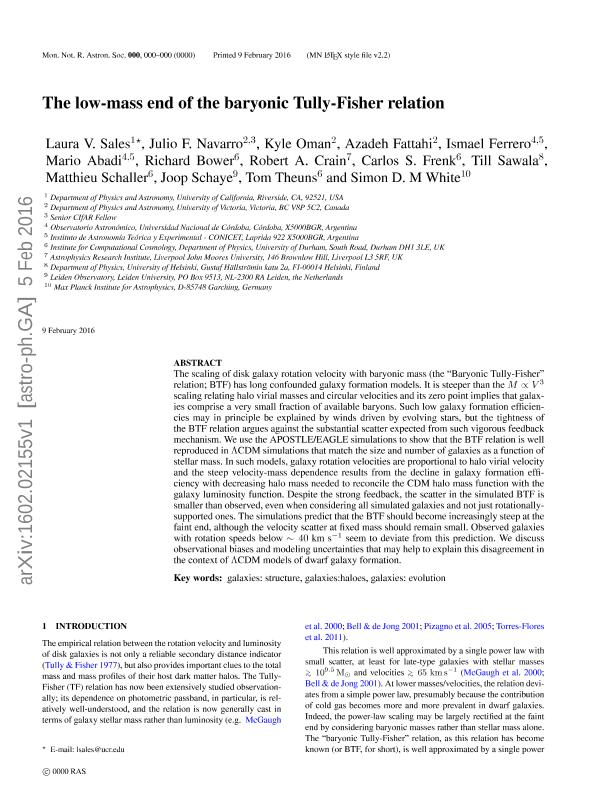Mostrar el registro sencillo del ítem
dc.contributor.author
Sales, Laura Virginia

dc.contributor.author
Navarro, Julio F.

dc.contributor.author
Oman, Kyle
dc.contributor.author
Fattahi, Azadeh
dc.contributor.author
Ferrero, Santiago Ismael

dc.contributor.author
Abadi, Mario Gabriel

dc.contributor.author
Bower, Richard
dc.contributor.author
Crain, Robert A.
dc.contributor.author
Frenk, Carlos S.
dc.contributor.author
Sawala, Till
dc.contributor.author
Schaller, Matthieu
dc.contributor.author
Schaye, Joop
dc.contributor.author
Theuns, Tom
dc.contributor.author
White, Simon D. M.
dc.date.available
2018-11-09T20:00:59Z
dc.date.issued
2017-01
dc.identifier.citation
Sales, Laura Virginia; Navarro, Julio F.; Oman, Kyle; Fattahi, Azadeh; Ferrero, Santiago Ismael; et al.; The low-mass end of the baryonic Tully-Fisher relation; Oxford University Press; Monthly Notices of the Royal Astronomical Society; 464; 2; 1-2017; 2419-2428
dc.identifier.issn
0035-8711
dc.identifier.uri
http://hdl.handle.net/11336/64144
dc.description.abstract
The scaling of disc galaxy rotation velocity with baryonic mass (the 'baryonic Tully-Fisher' relation, BTF) has long confounded galaxy formation models. It is steeper than the M ∝ V3 scaling relating halo virial masses and circular velocities and its zero-point implies that galaxies comprise a very small fraction of available baryons. Such low galaxy formation efficiencies may, in principle, be explained by winds driven by evolving stars, but the tightness of the BTF relation argues against the substantial scatter expected from such a vigorous feedback mechanism. We use the APOSTLE/EAGLE simulations to show that the BTF relation is well reproduced in Λcold dark matter (CDM) simulations that match the size and number of galaxies as a function of stellarmass. In such models, galaxy rotation velocities are proportional to halo virial velocity and the steep velocity-mass dependence results from the decline in galaxy formation efficiency with decreasing halo mass needed to reconcile the CDM halo mass function with the galaxy luminosity function. The scatter in the simulated BTF is smaller than observed, even when considering all simulated galaxies and not just rotationally supported ones. The simulations predict that the BTF should become increasingly steep at the faint end, although the velocity scatter at fixed mass should remain small. Observed galaxies with rotation speeds below ~40 km s-1 seem to deviate from this prediction. We discuss observational biases and modelling uncertainties that may help to explain this disagreement in the context of ΛCDM models of dwarf galaxy formation.
dc.format
application/pdf
dc.language.iso
eng
dc.publisher
Oxford University Press

dc.rights
info:eu-repo/semantics/openAccess
dc.rights.uri
https://creativecommons.org/licenses/by-nc-sa/2.5/ar/
dc.subject
Galaxies: Evolution
dc.subject
Galaxies: Haloes
dc.subject
Galaxies: Structure
dc.subject.classification
Astronomía

dc.subject.classification
Ciencias Físicas

dc.subject.classification
CIENCIAS NATURALES Y EXACTAS

dc.title
The low-mass end of the baryonic Tully-Fisher relation
dc.type
info:eu-repo/semantics/article
dc.type
info:ar-repo/semantics/artículo
dc.type
info:eu-repo/semantics/publishedVersion
dc.date.updated
2018-10-22T13:05:02Z
dc.journal.volume
464
dc.journal.number
2
dc.journal.pagination
2419-2428
dc.journal.pais
Reino Unido

dc.journal.ciudad
Oxford
dc.conicet.avisoEditorial
This article has been accepted for publication in [Monthly Notices of the Royal Astronomical Society] ©: [2017] [Laura V. Sales, Julio F. Navarro, Kyle Oman, Azadeh Fattahi, Ismael Ferrero, Mario Abadi, Richard Bower, Robert A. Crain, Carlos S. Frenk, Till Sawala, Matthieu Schaller, Joop Schaye, Tom Theuns, Simon D. M Whitee] Published by Oxford University Press on behalf of the Royal Astronomical Society. All rights reserved.
dc.description.fil
Fil: Sales, Laura Virginia. Consejo Nacional de Investigaciones Científicas y Técnicas. Centro Científico Tecnológico Conicet - Córdoba. Instituto de Astronomía Teórica y Experimental. Universidad Nacional de Córdoba. Observatorio Astronómico de Córdoba. Instituto de Astronomía Teórica y Experimental; Argentina. University of California; Estados Unidos
dc.description.fil
Fil: Navarro, Julio F.. University of Victoria; Canadá
dc.description.fil
Fil: Oman, Kyle. University of Victoria; Canadá
dc.description.fil
Fil: Fattahi, Azadeh. University of Victoria; Canadá
dc.description.fil
Fil: Ferrero, Santiago Ismael. Consejo Nacional de Investigaciones Científicas y Técnicas. Centro Científico Tecnológico Conicet - Córdoba. Instituto de Astronomía Teórica y Experimental. Universidad Nacional de Córdoba. Observatorio Astronómico de Córdoba. Instituto de Astronomía Teórica y Experimental; Argentina
dc.description.fil
Fil: Abadi, Mario Gabriel. Consejo Nacional de Investigaciones Científicas y Técnicas. Centro Científico Tecnológico Conicet - Córdoba. Instituto de Astronomía Teórica y Experimental. Universidad Nacional de Córdoba. Observatorio Astronómico de Córdoba. Instituto de Astronomía Teórica y Experimental; Argentina
dc.description.fil
Fil: Bower, Richard. University of Durham; Reino Unido
dc.description.fil
Fil: Crain, Robert A.. Liverpool John Moores University. Astrophysics Research Institute; Reino Unido
dc.description.fil
Fil: Frenk, Carlos S.. University of Durham; Reino Unido
dc.description.fil
Fil: Sawala, Till. University of Helsinski; Finlandia
dc.description.fil
Fil: Schaller, Matthieu. University of Durham; Reino Unido
dc.description.fil
Fil: Schaye, Joop. Leiden University; Países Bajos
dc.description.fil
Fil: Theuns, Tom. University of Durham; Reino Unido
dc.description.fil
Fil: White, Simon D. M.. Gobierno de la Republica Federal de Alemania. Max Planck Institut Fur Astrophysik; Alemania
dc.journal.title
Monthly Notices of the Royal Astronomical Society

dc.relation.alternativeid
info:eu-repo/semantics/altIdentifier/url/https://academic.oup.com/mnras/article-abstract/464/2/2419/2404621/The-low-mass-end-of-the-baryonic-Tully-Fisher?redirectedFrom=fulltext
dc.relation.alternativeid
info:eu-repo/semantics/altIdentifier/doi/http://dx.doi.org/10.1093/mnras/stw2461
dc.relation.alternativeid
info:eu-repo/semantics/altIdentifier/url/https://arxiv.org/abs/1602.02155
Archivos asociados
